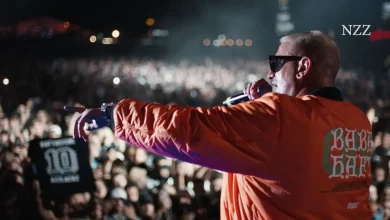How Youtube revenue is fuelling Talksport’s transformation into video brand

Four presenters present the programme Goals in Talksport’s new studios
Talksport has invested in a studio upgrade to help boost video content as it further transitions from traditional radio station to being a more video-focused brand.
The decision to focus more on its video strategy was made in 2019/20, when “we started putting cameras in all the studios and started filming everybody like laboratory rats from 6am”, said Derek Brown, News UK’s director of digital for broadcasting.
“We don’t think of ourselves as a radio station anymore, but a multi-platform sports brand…where people are as likely to be watching us as listening to us,” he added.
“There’s a great story about when a young person came in for an interview …and he was asked about Talksport as a radio station, and suddenly looked a bit blank, and he went… ‘I thought it was a Youtube channel.’ So that’s a nice problem to have, where people under a certain age think we’re a Youtube channel.”
The studios, first built in 2018 at parent company News UK’s News Building HQ in London, were “gutted” in the summer of 2025 to be “state of the art”.
The revamp saw more and better-quality cameras installed to “allow better framing of guests and more of them”, said Brown.
The new space has also created a news bulletin area with a full autocue and higher spec LED screens to improve graphics, alongside the introduction of licensing platform Flowics, “which gives us full access to put live scores, league tables and line ups on screen”, and “more visualisation than we were able to do before” with the brand livestreaming 24 hours a day.
“Actual live filming is 6am until 1am – we run repeats through the night on the stream… We couldn’t continuously stream this period in the old studio because of ad breaks.”
Brown added that working with “our new visualised vodcast studios elsewhere in the News building”, Talksport can tailor content for specific audiences.
“We make various club-specific shows for example and a boxing show – and for sponsors who would traditionally only hear their brands read out on air. Now, increasingly, they want their logo on screen.”
He added: “Twenty-five years on we don’t really think of Talksport as a radio station anymore… we think [of it] as a sports opinion brand on whatever platform people want to consume it on.”
A before and after shot of the new Talksport studios
‘Youtube is where we monetise the most’
Since beginning filming in the studios, Talksport has become more Youtube-focused as a brand, publishing “anywhere between 35-40 ten-minute videos from Talksport every day, where the team is just cutting visual content and putting it on Youtube”.
“We obviously use all the platforms, but Youtube is where we monetise the most,” Brown said.
Talksport makes money from video from Youtube’s advertising revenue share, from direct-sold pre-roll ads and via sponsorship and branded content.
“We are in the Youtube Partner Programme so we can sell direct pre roll, which we do quite a bit of on our content,” Brown said.
“Youtube is biggest and where virtually all our digital video revenue comes from. August was a record month for programmatic revenue across all our 16 Youtube pages by some margin,” he added.
“September was just behind. The studios were completed in July. October is going to be a strong month… Talksport Youtube revenue has grown 63% on the previous August.”
Talksport’s Youtube pages include “things like cricket, golf, F1, football”, and the brand has just launched a World Cup page.
“So, yeah, we do about 35 to 45 million Youtube views a month. It’s the biggest growing part of our digital portfolio,” said Brown.
Talksport has some 1.8 million followers on Youtube.
According to Rajar, Talksport had a weekly reach of 3.4 million people in the third quarter of 2025.
According to Similarweb, Talksport.com had 12.5 million global website visits in September.
Advertising revenue share from Facebook is also significant for Talksport.
“I don’t care what anybody tells you, the other platforms are generally rubbish for monetisation. Facebook is getting better,” Brown said.
“They are changing their the way that they monetise content now, which is interesting… they want to keep people on Facebook. They used to push people out to websites and links and all that.
Now, Facebook bundles “all types of content, whether it’s a video or a graphic or something visual as content now, and as long as somebody engages with that content – likes, comment, shares, spends a bit of time on it – they reward it all.”
Brown added the monetisation for Facebook has “got better” in the last three months.
People powered, AI accelerated
“We’re now starting to use AI to really start figuring out how we can slice and dice and cut the content properly,” said Brown.
“We’ve just developed a thing called On Air, which basically is an AI ear which listens to that output all day… let’s say you’re an Arsenal fan, what On Air does is it will listen to the entire 24-hour content of Talksport. It will set a beginning and an end time, and it will package up one video or podcast of just the times they spoke about Arsenal during that day, and deliver it to you.
“So literally, it will strip out the conversations about Arsenal in one day without us doing anything, package it together, and we can actually serve that to different audiences.”
The tool has the ability to create an hour-plus long piece of audio content five minutes after the show has finished.
While there is speculation that AI being introduced to newsrooms has led to cuts, Brown said: “We’re people-powered, because we’ll always have presenters sitting there giving their opinions, because you never know what that come out their mouths. But we’re AI accelerated.
“So, we use the AI to take all that heavy lifting that we needed banks of people sitting at desks to do before, but we’ll always have people sat in our studio.”
Brown added that that AI will allow the studio to “make tonnes more content and deliver it in about 100 different new ways”.
“I think will save me a lot of heartache, because I’m constantly battling headcount, in terms of ‘we want to do this’, but we don’t have enough people to do it.”
Talk, Talksport and Times Radio: ‘Vast digital video machine’
News Broadcasting oversees video output from four brands: Talksport, Talk, Times Radio and Virgin Radio.
There are 32 Youtube pages across all three, Brown shared, adding: “Across all these radio stations, what they traditionally were, we’ve actually created, at the back end of it, a pretty vast digital video machine, which is all owned content.
“Even on those three core pages we’re publishing about, I would say, 100-plus ten-minute videos a day, which is pretty high.”
He added that Talk is the “highest volume” in terms of content, describing the output as “quite machine gun – issue, issue, issue”.
“We do about 45 videos a day on Talk.”
[TalkTV hits 1m Youtube subscribers and grows revenue after linear TV closure]
“Times Radio, we publish about 20 to 25 videos a day on the main page,” he said, adding there is also a Times Radio tech page, history page and UK politics page with Andrew Neil.
“And they’re all doing pretty well.
“The dirty little secret about making video really well… is that if you want to make really good video at high volume, make a radio station and put cameras in it,” said Brown.
“I think I can say with a large degree of confidence that Talksport, and the other News [UK] broadcasting brands, are now the most watched traditional radio stations in the world. I’m happy to be proved wrong though.”
Talksport Ltd growing revenue
News UK’s radio stations report their financial figures as Talksport Ltd (which includes Talksport, Talk, Times Radio and the Virgin radio brands).
It reported turnover of £82.7m in the year to the end of June 2024 (up from £81m) and profit of £12.1m (up from £11.8m).
Email pged@pressgazette.co.uk to point out mistakes, provide story tips or send in a letter for publication on our “Letters Page” blog





